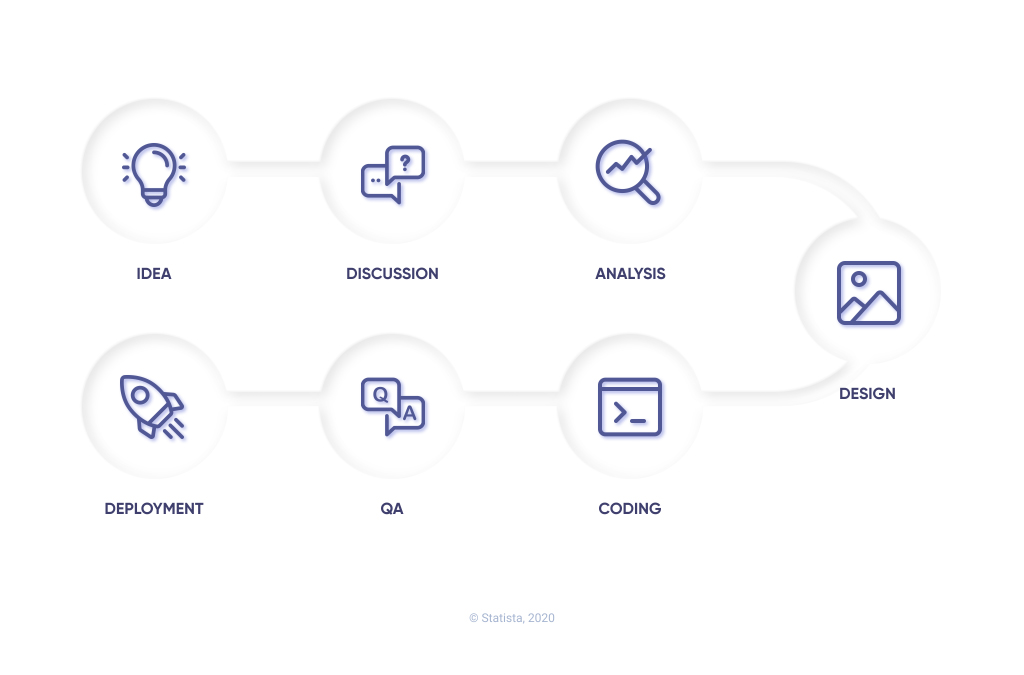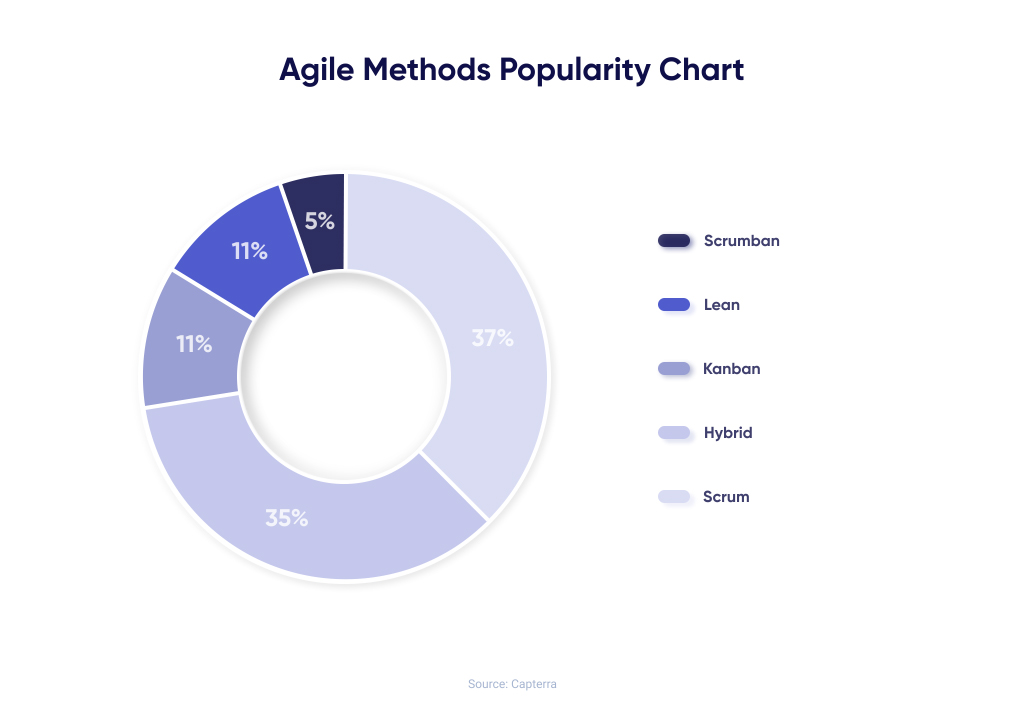In the 2020s, any, literally, any entrepreneur, who wants to see the revenue soar, has to approach the software development team at some point. And it doesn’t matter whether you choose to build the in-house team or outsource: you still have to work with someone who can give your idea that perfect digital incarnation.
No denying, it’s way more manageable when you have at least some sort of IT experience and have even the slightest idea of how digital solutions are created. But what if you don’t? What if all you have is a great business idea that can change the world for the better? How to understand what’s going on during the development process? What are the duties of each expert? How not to get ripped off by some random scammers? So many questions! And we’re going to answer them all in this article!
Why is judicious selection so important?
So, you’re on a mission and need to find the software development team and find it quickly. Entrepreneurs are aware of how valuable time is, and how every day without a website or an app brings significant financial losses. But here’s the thing, choosing the right team for your project’s implementation is a phase you need to take your time with.
Picking the first available team with affordable rates may lead to horrifying consequences such as:
- schedule overrun
- miscommunication
- low-skilled developers
- poor quality work
- money and time loss
- emergency alterations or rebuilding the product from scratch
Luckily, all these downfalls are 100% preventable. You just need to prepare and puzzle out which type of IT dev team works for you.
3 Types of Teams you need to know about
In a nutshell, every IT team in this world fits the mold of one of three approaches: generalists, specialists, and hybrid. There’s no “the good one” or “the bad one”. Each type is just more suitable for certain projects.
Generalists
Jack of all trades is a perfect metaphor for this approach. Generalists are proficient in a wide range of IT tools/technologies and can deliver high-quality solutions of low and medium complexity.
Generalists are perfect when the budget is limited, the project is time-sensitive, and you need a complete solution.
But one soft spot of this approach is its comprehensiveness. Generalists lack the depth and specific skillset when it comes to fulfilling the tasks that require focused specialization. However, this problem is pretty easy to solve by hiring a third-party contractor that can help with implementing those specific tasks.
Specialists
The metaphor for this approach is a laser. Specialists do not spread themselves too thin. It’s that type of team where each member is an expert in one area and knows all about it.
This approach helps perfectly execute the complex projects that require the intimate knowledge of particular subjects and/or technologies. Highly complex solutions are built faster when you opt for specialists.
At the same time, specialists may lack coordination and cohesiveness. Every single element of the project may be executed perfectly, but it doesn’t mean that all of the “puzzle pieces” will fit into the final product.
Hybrid Teams
At first, it might seem like the perfect combo. Just mix everyone in one team and let them do what they can do best. And that’s what hybrid teams are all about.
The hybrid approach definitely includes all of the best things about the other two types while eliminating obvious weaknesses. It’s perfect for complex, large-scale solutions where you require both flexibility and a high level of expertise.
But what seems like an invincible approach sure has its own downsides. Hybrid teams aren’t only the most expensive to work with but also require strong management that can coordinate all the diverse parts of the workflow.
The Most Common Software Development Team Structure
All of the software development teams are unique and justified as there are so many different projects out there! The structure model we’ll talk about in this article isn’t “the one and only”. It’s just the most common way to organize the workflow and delegate responsibility. With that being said, let’s dive right into it! 
1. PM
“Being a PM, I pass the customer’s demands and vision on to the developers. I also make sure the project is completed within the discussed timeframe and budget”.
(Yurii Oliinyk, Project Manager at Light IT)
The project manager probably has the longest list of duties among all the other teammates. This person is just like a conductor: (s)he orchestrates the whole team and turns separate tones into a beautiful symphony. A qualified PM plans, organizes, controls, schedules, analyzes, delegates, manages, reports, and communicates to make sure the work is done and it is done right.
PM’s main responsibility is to do whatever it takes to deliver a solution the customer needed. And considering the fact that the PM doesn’t actually build the product, it’s not the easiest task to pull off.
Project managers professionally translate from IT to Human and vice versa. They understand both the customers (who may not have any tech background) and the developers equally well. It’s safe to say that without a project manager any kind of idea is extremely likely to never get that implementation,
2. Business Analyst
“As a Business Analyst, my goal is to understand the client’s business needs and then translate them into explicit requirements for the project”.
(Korinna Filina, Business Analyst at Light IT)
Every entrepreneur is willing to invest in high-quality IT solutions to get more profits in the future. In order to do that, you need to ensure the final product meets the market demands and the customers’ needs. A Business Analyst can help you with that!
This person protects your business needs and double-checks that the solution, which is perfectly executed from the technical perspective, is also effective from the business perspective.
3. Developers
These are the “tech gurus”, the masters of code that turn gibberish on the computer screen into a fully-functional solution. And even though they all code, different types of developers make different kinds of magic happen.
Front-End Developer
“My job is to translate designs into the user-friendly user-facing functionality. I also make sure the user has the same experience regardless of the chosen device”.
(Pavel Vakula, Front-End Developer at Light IT)
Among all of the developers, front-end experts probably get the most recognition as the results of their work are always visible. They convert beautiful designs into code and strive for a smooth and pleasant user-experience.
Search bars, input fields, images, navigation, animation, buttons, and all the other elements that make a website or an app both useful and user-friendly are created by the front-end developer.
At the same time, front-end bugs and glitches are also the most prominent, so alongside getting a lot of praise, front-end developers usually receive the most critique as well.
Back-End Developer
“I write clean code to transform the text requirements into a working solution. I’m responsible for the app’s architecture, logic, and the smooth interaction of all of the system’s components”.
(Sergii Levich, Back-End Developer at Light IT)
Back-end developers (like all the other developers) do code. But their skillset is not limited to coding alone. They build the project’s core. They are the ones responsible for the logic, the architecture, third-party solutions integration, data computing, and the overall system’s stability.
The end-user doesn’t see the work of the back-end developers because all of the code is “hidden” behind the beautiful designs and front-end. Still, highly skilled back-end gurus can make or break the project by either building a solid base for the project or creating a giant with feet of clay.
Mobile Developer
“I’m a mobile developer, and I specialize in building software for mobile devices (not only smartphones). The area of my expertise is building cross-platform apps but some of my peers create native apps”.
(Eugene Averin, Mobile Developer at Light IT)
In the next ten years, computers will eventually yield the palm to mobile devices (smartphones, tablets, wearables). In fact, by 2025, about ¾ of the Internet users will use only mobile devices. So the role of the mobile developer will become more and more important.
Mobile developers turn business ideas into functioning apps. These people have built all of the most popular apps out there: Instagram, TikTok, Uber, WhatsApp, etc. Mobile pros usually specialize either in Android or iOS app development. However, there are some experts that choose hybrid apps as their specialization or can work with any type of mobile development.
4. Team lead
“The Team Lead combines the skills of the manager with the competence of the developer. I help the dev team to stay productive and inspired. I eliminate all of the possible distractions and blocks for the team”.
(Egor Usatuy, Team Lead at Light IT)
The Team Lead actually has a lot in common with the Project Manager. (S)he manages the dev team, but where the PM is usually assigned per project, the Team Lead tends to be a permanent role.
Team Leads “guard” the developers communicating directly with the PMs and/or Business Analysts. It helps to kill two birds with one stone: managers get the regular status updates, and the developers are not distracted.
At the same time, a Team Lead may play the role of a coach, helping to resolve more complex tech tasks, and reviewing the code.
5. Designer
“I create beautiful modern designs and branding to make the final product as appealing and eye-catching as possible. I also work on providing the best user experience possible”.
(Anastasiia Shendrik, Designer at Light IT)
Design is so much more than just amazing graphics and color coordination. Designers worry not only about that but also about the user experience because the customer’s satisfaction translates into higher conversion rates.
Designers have to be psychologists in a way. It’s their responsibility to analyze and predict the users’ behavior to enhance engagement and improve the customers’ journey.
6. QA Specialist
“I look for bugs and malfunctions in the developed software and make sure it works perfectly on different devices”
(Vitalii Ternovets, QA Specialist at Light IT)
Even after the most well-thought-out and careful development process, there will be some oversights. QA Specialists spend hours looking for possible bugs and then reporting them to the development team so that you could enjoy a smoothly running app or website.
QA Specialists always use several test environments, devices, and tools to conduct the most comprehensive research and ensure the best end result for the whole team. QA is so important that it can easily place in jeopardy the work of many people (if done poorly) or give the company a credibility boost (if done professionally).
Agile software development team roles and responsibilities
Agile methodology is the “IT religion” in a way. As the name implies, Agile is all about being flexible and able to adapt to the constantly changing requirements and fresh ideas the customer (or the team) may come up with.
It’s also an “umbrella term” for quite a few frameworks that may differ but still are aligned with the core Agile principles.
As a study by Capterra shows, Scrum remains the most popular Agile framework out there, and Kanban takes the second place when it comes to the “one method only” approach. But then again, 35% of the software development teams opt for hybrid methodology. 
If you want to know more about the topic, check out the article about types of PM methodologies. Meanwhile, here we’ll concentrate only on the main differences between the project team roles and responsibilities in software development using two of the most popular frameworks: Scrum and Kanban.
What makes a Scrum team?
Even though Scrum is an Agile framework, it’s main forte is structure. The workflow is divided into several stages called “sprints” that usually last from two weeks to 30 days. The team plans a certain scope of work that should be ready by the end of the sprint, and changing it “on the go” once the sprint has started isn’t encouraged.
The most prominent features of the Scrum team are the unique structure and particular roles that aren’t common for other frameworks.
- Product owner
- Scrum Master
- Development Team
A product owner is a person that guards the interests of the client and gets the customer’s feedback across to the development team. One of the product owner’s main duties is to manage the backlog and make sure all the items are visible and clear. It’s also a person that directly communicates with the client and guarantees the feedback is processed into a valuable product.
Scrum Master is a mediator between the product owner and the dev team. This person’s main responsibility is to keep the team focused, so (s)he is usually involved in resolving any kind of issues that may appear and distract the team. Another thing that Scrum Master is responsible for is arranging and conducting all types of meetings and coaching the development team, ensuring the highest level of cross-functionality and self-organization.
The development team is an umbrella term for all the pros that actually implement all the scope of work in each sprint. Remember the six most common roles listed above? Well, in Scrum, all of the business analysts, developers, QA-engineers, designers, etc., are just members of one development team. While no one tells the dev team how to implement each task, it has all the skills needed to turn the backlog into the product increment.
What is a Kanban Team?
As you already know, Scrum is about combining structure and flexibility. Kanban is about the workflow. It uses the Kanban board to track the tasks and control the workflow. Kanban is considered to be more flexible than Scrum because it doesn’t limit the amount of work with sprints. You can change the priorities and create new tasks daily. However, “work in progress limits” help to prevent the overburden.
When it comes to Kanban team roles and duties, it’s a little tricky. Some are 100% positive it has no specific roles as it’s not necessary for the cross-functionality. The others insist that there are two vital Kanban roles: Service Request Manager and Service Delivery Manager.
A service Request Manager is someone who’s aimed to listen to the customer and make sure the team’s work translates into customer satisfaction in the end. This person plays a major role in prioritizing by helping to reveal the value of each part of the project.
A service Delivery Manager is a person that inspects the workflow, ensuring timely delivery, promoting continuous improvement activities, and controlling the tasks moving through the Kanban system.
How to find a “perfect” team for your project
Now that you’re equipped with all the basic knowledge about modern IT teams, you still may wonder how to choose that “perfect one”, an effective software development team that will not disappoint, especially when most of the teams have a similar structure and offer comparable services.
The thing is, there’s no absolute answer to this question. But there sure are some of the things you should keep in mind while building or hiring a team for your project.
- Outspokenness and willingness to communicate
IT is definitely that industry where “bad news is good news, and no news is bad news”. Nothing harms the project more than silence and stonewalling. Remember that it’s totally ok if, during the development process, some unexpected challenges come up. But it’s not ok when the developers just remain silent and pretend nothing is happening.
- Ability to set clear goals
Even if the end goal is pretty obvious, like “build a high-quality healthcare app”, it’s very important for each team member to understand the end result (s)he should strive for. Otherwise, it will be very hard to not only finish the project but even plan the workflow.
- Support for risk-taking and unconventional solutions
Rules and common practices are important, especially in such things as coding. However, it’s also vital to stand out, and if the team members can think out-of-the-box and offer your project something unique and special, it’s a good thing.
- Belief in the work’s value
This may sound cliche, but successful, effective, and trustworthy teams do not work in IT just because it’s profitable. Members of the “perfect” team genuinely believe that their work matters and makes a difference. It affects not only the development process but also the quality of the finished product.
- Argumentation
Entrepreneurs requiring an IT solution may have a very distinct vision of their app or website, and sometimes they may opt for the specific features, tools, or technologies that, in their opinion, are mandatory. However, that’s not always the case, and a good team is not afraid to discuss every detail with the client, sometimes offering alternatives that will work better. Reasoned disagreement is very important, and if a team is open to discussion, it’s a great advantage.
Final Words
All the teams in a diverse IT world are so different yet so similar. They all shape amazing ideas into a modern digital form but do it using different methodologies and instruments.
It’s ok to feel lost and overwhelmed at first. It’s ok not to rush and take your time for a well-thought-out decision. And if you ever need assistance with your project, you can always contact the Light IT team. We’ll be happy to help you with any task: from a professional consultation or a project estimation to full implementation and post-production maintenance.




